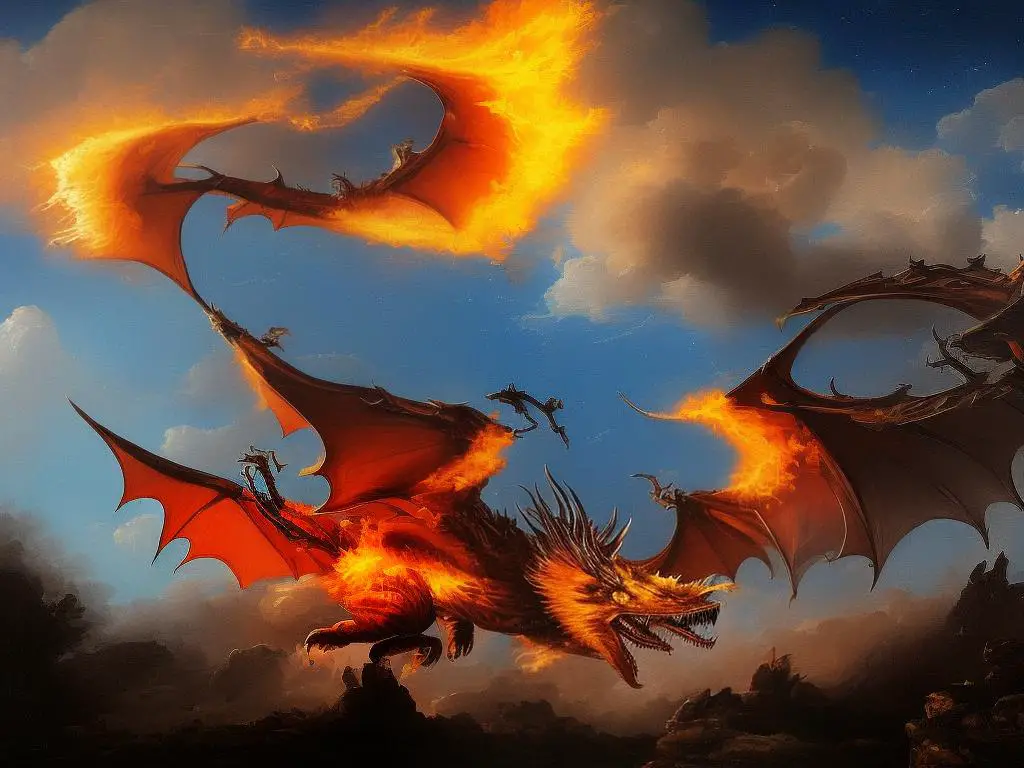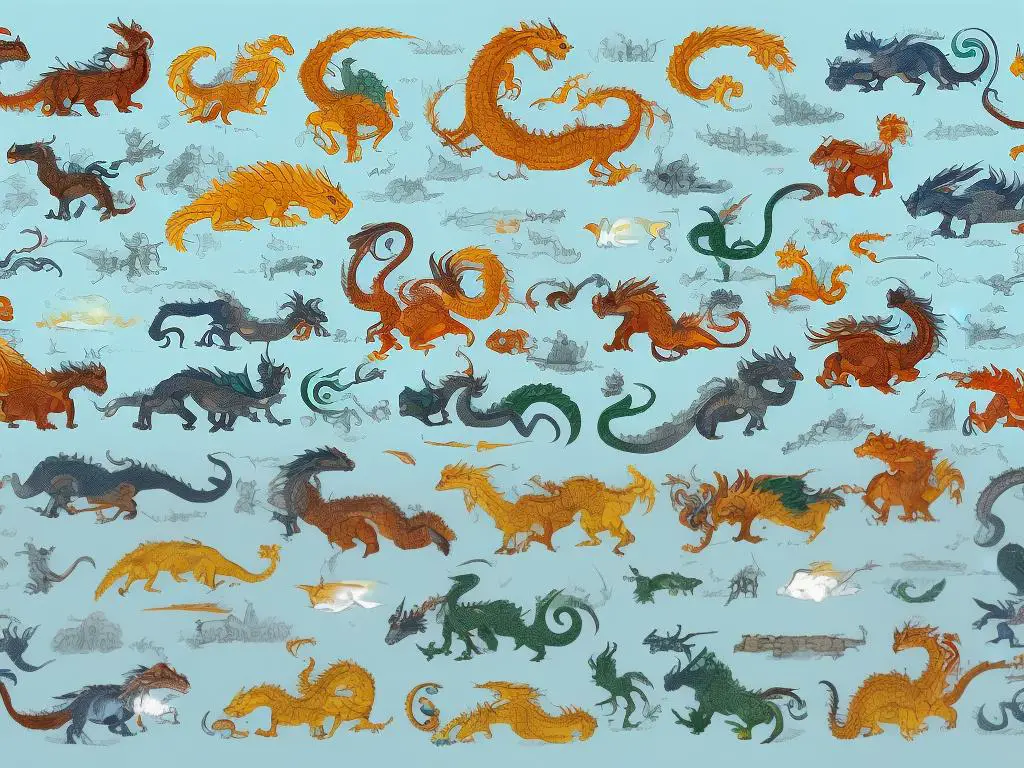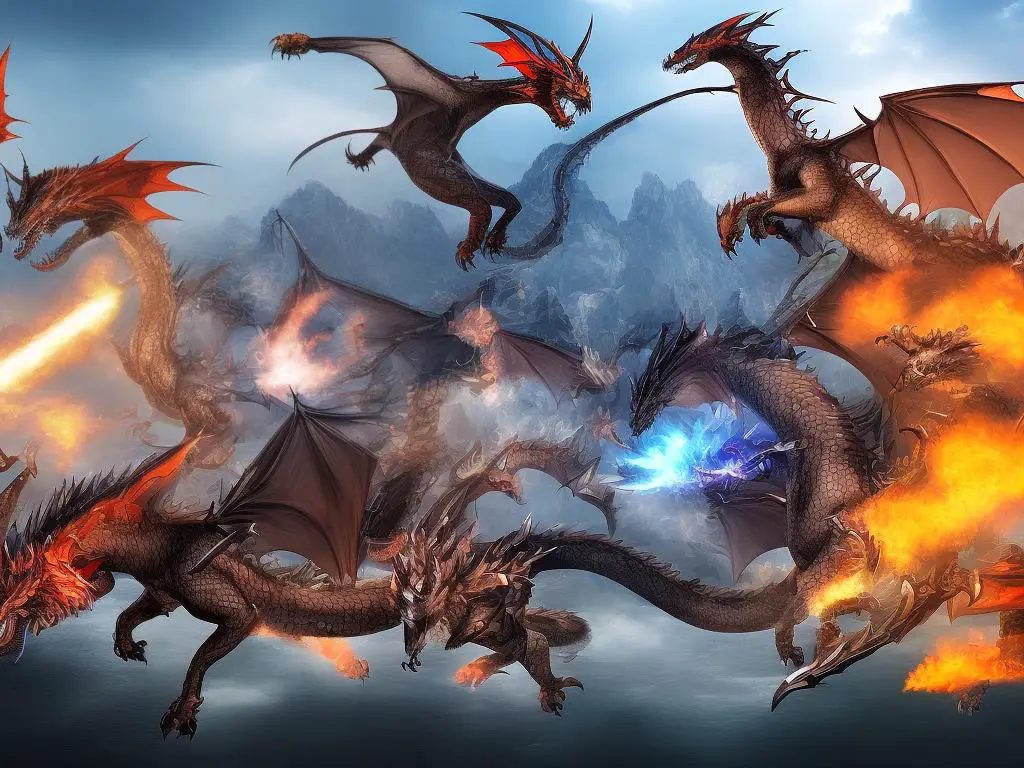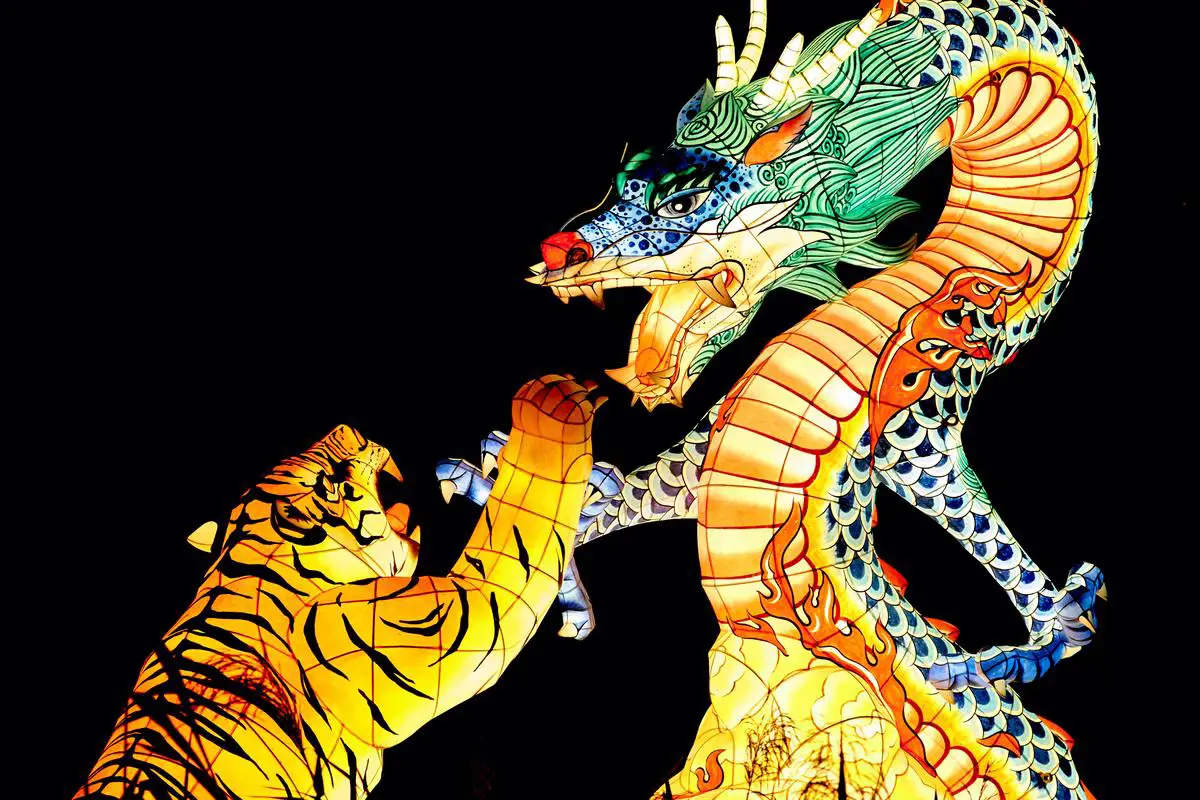Throughout history, dragons have captured the human imagination as powerful, enigmatic creatures that have played prominent roles in myths, legends, and popular culture. As symbols of wisdom and chaos, guardians, and adversaries, dragons have taken on myriad forms and functions across different cultures, reflecting our ever-evolving understanding of these fascinating beings. This analysis delves into the rich tapestry of dragon lore and explores the historical, cultural, and linguistic aspects of these mythical creatures, dissecting their origins, symbolism, and influence in various aspects of society and popular media.
Historical and Cultural Perspectives on Dragons
Dragons in Mythology and Folklore
Dragons have played a significant role in the mythology and folklore of different cultures throughout history, reflecting diverse perspectives and depictions based on local beliefs and narrative traditions.
Chinese Dragons
In China, the dragon – or ‘Long’ – is a symbol of power, wisdom, and prosperity. Emperors were closely identified with these mythical creatures, using their imagery to assert their divine authority. Chinese dragons often have long, serpentine bodies, and are believed to control the elements, especially water, and are thus associated with floods, rain, and storms. Dragons in Chinese culture represent benevolent, auspicious beings that are revered, rather than feared, in contrast to their Western counterparts.
Japanese Dragons
Japanese dragons, while sharing some similarities with the Chinese Long, are distinguishable in their unique cultural context. The Japanese dragon – or ‘Ryū’ – possesses three claws, whereas the Chinese dragon typically has four or five. As with Chinese dragons, Ryū are usually regarded as benevolent entities, associated with deities and embodying elements of nature. In Japanese mythology, they are often found in connection with Shinto shrines and Buddhist temples, indicating the deep integration between dragons and religious traditions.
European Dragons
European dragons, in contrast to their Eastern counterparts, are often depicted as menacing, fearsome creatures, symbolizing chaos and malevolence. Originating in ancient Greek and Roman mythologies, these dragons typically display the characteristics of reptilian serpents or large, fire-breathing lizards with wings and sharp claws. In many European legends, dragons are associated with hoarding treasure, hidden secrets, or guarding sacred objects. Heroes in these tales frequently embark on a journey to slay these monstrous beings, representing the triumph of order and good over their treacherous foes.
Dragons in Other Cultures
Besides the well-known examples from Chinese, Japanese, and European myths, dragons can also be found in a multitude of other cultures and origins. In Mesoamerican civilizations, such as the Aztec and Maya, the feathered serpent deity Quetzalcoatl was yet another manifestation of the dragon archetype. Similarly, in Hindu and Buddhist traditions in South Asia, the serpent-like Nāga often plays a vital role in mythology, embodying elements of fertility and protection, and serving as custodians of the cosmic order. The pervasive presence of dragons in diverse global mythologies underscores their profound significance within human culture and spirituality.
Dragons in Art and Literature
Art and literature throughout history have consistently depicted and elaborated upon dragon lore, revealing the depth and complexity of these symbolic creatures.
Dragons in Visual Arts
From ancient Chinese scrolls and Japanese woodblock prints to medieval European illuminated manuscripts and Persian miniature paintings, dragons have remained enduring subjects in visual arts.
The Symbolic Potency of Dragons
Dragons hold a significant place in the cultural heritage of various societies due to their mysterious origins and the powerful symbolism they invoke. These enigmatic serpent-like creatures, often seen as benevolent, fearsome, or something in between, have time and again captivated the human imagination and transcended cultural boundaries.

Etymology and Linguistics of Dragon Terminology
Exploring the Etymology and Linguistics of Dragon Terminology
One key aspect of understanding the origins and significance of dragons is delving into the etymology and linguistics of dragon-related terminology across different languages and cultures. The word ‘dragon’ comes from the Latin term ‘draco,’ which itself is rooted in the ancient Greek word ‘drakon.’ In Greek mythology, a ‘drakon’ represents a large serpent or sea monster, often wielding fearsome, supernatural powers. This depiction of an incredibly powerful, monstrous being has remained consistent throughout history and continues to be a universally recognized symbol in various languages and cultural contexts.
Dragon Terminology Across Cultures
In Eastern cultures, the term ‘dragon’ has linguistic counterparts that add variety to the creature’s mythological characteristics. For instance, in Japanese mythology, the term ‘tatsu’ refers to dragons as benevolent, serpentine creatures associated with water and the forces of nature. Similarly, in Chinese culture, the term ‘long’ is used to describe these creatures, which are also considered to possess divine powers and are revered as symbols of fortune and prosperity. These variations in the linguistic representation of dragons point to the cultural differences in the perception of these mythical beings yet highlight the widespread prevalence of their existence in folklore and mythology.
The Study of Linguistic Evolution
Investigating the potential connections between the various terms for ‘dragon’ allows for a fascinating study of linguistic evolution. In the case of the Greek ‘drakon,’ the Proto-Indo-European root ‘*derk-‘ meaning ‘to see’ has been suggested as a possible origin. This implies that the ancient Greeks may have envisioned these creatures as having an intense, piercing gaze, which could potentially be linked to their legendary association with wisdom and knowledge. Conversely, the Japanese ‘tatsu’ and the Chinese ‘long’ can be traced to the linguistic roots of the respective languages, revealing regional particularities and distinctive insights into the attributes bestowed upon these mythical beings.
Incorporation of Dragon Terminology Across Languages
Another interesting dimension in the etymology of dragon terminology is the incorporation of these words into various other languages, leading to the adoption and adaptation of dragon folklore across different regions. In the Slavic languages, the term ‘zmey’ or ‘zmeu’ is used to describe a dragon-like creature, drawing comparisons to the Greek ‘drakon’ and the Latin ‘draco’ while still retaining unique characteristics such as the ability to shapeshift and a connection to elemental forces. Similarly, the Old English word ‘draca,’ borrowed from the Latin ‘draco,’ has led to the modern English term ‘dragon,’ demonstrating an enduring and evolving connection between these languages and their mythical creatures.
Global Fascination with Legendary Beings
The ongoing study of the etymology and linguistics of dragon terminology continues to reveal fascinating discoveries and connections, emphasizing the cultural pervasiveness and significance of these mythical creatures. By delving into the numerous linguistic variations in the concept of the ‘dragon,’ we can gain deeper insights into the global fascination with these legendary beings. Furthermore, these distinctions highlight humanity’s innate need for storytelling and the creation of shared, cultural myths that transcend linguistic and geographical boundaries.

Anatomical and Physiological Features of Dragons
Dragons: A Mythical Exploration
Dragons are mythical creatures that have captivated the human imagination for centuries and are commonly depicted as having serpentine or reptilian traits. These include scales, elongated and powerful bodies, sharp claws, and teeth. Intriguingly, some real-life creatures, such as the Komodo dragon and specific snake and lizard species, possess characteristics that could be seen as dragon-like. Thus, it seems plausible that legends of dragons were inspired, at least partly, by the observation of these actual animals.
Dragon’s Wings
One of the most distinct and iconic features of dragons is their wings, which are commonly depicted as being bat-like in structure, spanning across vast sections of their backs. This design would allow for optimal surface area to generate lift during flight, mirroring the anatomy of bats and pterosaurs. However, the immense size and weight of dragons in folklore call into question the plausibility of flight. Flight adaptations in large animals tend to come at the cost of weight and power, meaning that it would be challenging for a dragon to maintain both its considerable size and the capacity for sustained flight.
Fire-breathing Dragons
Perhaps the most fantastical ability attributed to dragons is their capacity to breathe fire. In order to generate the combustible materials necessary for fire-breathing, a dragon would need to produce a highly flammable substance, such as methane or hydrogen, as a byproduct of its metabolism. Some insects, like the bombardier beetle, employ a similar tactic when they release a heated mixture of chemicals as a defense mechanism. However, the process of producing and storing enough flammable gas would present significant challenges, such as maintaining appropriate pressure and avoiding accidental ignition.
Dragon’s Regeneration Ability
In addition to fire-breathing, dragons are often thought to possess a range of other supernatural abilities, such as the ability to regenerate lost limbs or heal at impressive rates. The idea of rapid regeneration might stem from the observation of reptiles’ capacity to regrow lost appendages, like tails. Nevertheless, true limb regeneration in reptiles is relatively limited, and the concept of a dragon rapidly healing from significant injuries without major consequences seems biologically improbable.
Dragon’s Extraordinary Senses
Dragons are also often depicted as having exceptional senses, with some legends speaking of their ability to sense the faintest movement or hear the quietest sound. This is not entirely implausible when considering the highly developed senses of many animals in nature. For instance, snakes use their forked tongues to taste chemicals in the air, giving them an acute sense of smell that assists in navigation and prey detection. Similarly, some aquatic organisms possess a lateral line system that allows them to detect even the smallest water movements. While the idea of dragons possessing a full range of these advanced senses might be fanciful, it is nevertheless rooted in elements of biological reality.

Dragon Imagery and Symbolism in Religion and Mythology
Dragons in Mythology and Culture
Having explored the biological plausibility of dragons, it is crucial to understand their impact on mythologies and religions of numerous cultures around the world. Often associated with power, wisdom, and chaos, the dragon has come to symbolize various aspects of human nature and society. The prevalence of dragon-like creatures across different cultures further suggests that these creatures may share common origins in the human experience, perhaps as a result of encounters with reptilian or other dragon-like fauna. The lasting influence of dragon myths not only emphasizes the power of human imagination, but also offers a unique perspective on our cultural and historical connections.
Christian Mythology
In Christian mythology, the story of St. George and the Dragon exemplifies the battle between good and evil. St. George, the patron saint of England, is often depicted slaying a dragon, which represents the devil and sin. This act of heroism symbolizes the triumph of Christianity over paganism and the protection offered by divine forces against malevolent beings.
Norse Mythology
In Norse mythology, the dragon Fafnir represents greed and destructive power. Originally a dwarf, Fafnir was transformed into a dragon after killing his father and stealing a cursed treasure. This transformation highlights the destructive nature of excessive desire and the potential for people to abandon humanity in pursuit of power. Fafnir’s eventual death at the hands of the hero Sigurd symbolizes the victory of good over evil and the importance of maintaining moral fortitude in the face of temptation.
Chinese Mythology
Chinese mythology presents a contrasting view on dragons, often depicting them as benevolent creatures possessing attributes of wisdom, strength, and prosperity. In ancient Chinese culture, the dragon was seen as the symbol of the emperor, highlighting the emperor’s divine connection and supreme power. Dragons continue to be an important symbol in Chinese culture, playing a major role in festivals like the Chinese New Year, where dragon dances are performed to bring good fortune and ward off evil spirits.
Mesoamerican Myths
In Mesoamerican myths, the feathered serpent deity Quetzalcoatl represents the duality of life, embodying both chaos and creation. Quetzalcoatl was considered a god of wisdom, agriculture, and craftsmanship, symbolizing the connection between human growth and the natural world. His presence as a dragon signifies the mysterious, transformative power associated with divine entities. In this mythology, the dragon’s ability to shape-shift from a serpent to a bird exemplifies the concept of change and metamorphosis, illustrating the ever-evolving nature of life and culture.
Dragons and the Human Condition
Dragons in various cultures serve as a potent symbol of the human condition, exploring themes of transformation, chaos, and morality. These mythical creatures embody the duality of human nature, being capable of both good and evil, and allowing cultures to examine their beliefs about the essence of humanity. The enduring presence of dragons in religious and mythological narratives demonstrates the timeless nature of these themes, as well as the captivating allure that these mythical creatures continue to hold in the human imagination.

Dragons in Popular Literature and Media
Dragons in Popular Culture
Dragons have long captured the imagination of audiences young and old, consistently appearing in various shapes and sizes throughout literature and media. One of the most influential high fantasy novels to prominently feature dragons is J.R.R. Tolkien’s “The Hobbit” (1937), which introduced the iconic antagonist, Smaug the dragon. This fierce and intelligent creature, guarding a vast treasure, has set the standard for many subsequent portrayals of dragons, cementing the image of a fire-breathing reptilian beast with a craving for gold. This characterization has resonated with readers and viewers alike, reinforcing the archetypal dragon figure in popular culture.
However, not all dragons in literature are presented as deadly adversaries. Anne McCaffrey’s highly regarded “Dragonriders of Pern” series (1968-2011) portrays dragons as highly intelligent creatures who bond with humans, becoming lifelong companions and protectors. This more sympathetic portrayal provides readers with an alternative interpretation that emphasizes the deep, emotional connections possible between humans and dragons, showcasing an inventive twist on the classic dragon stereotype.
In film and television, dragons continue to enjoy popularity. The HBO series “Game of Thrones” (2011-2019), based on George R.R. Martin’s book series “A Song of Ice and Fire”, features Daenerys Targaryen and her three dragons as major characters. These dragons, portrayed as awe-inspiring, enchanted creatures with a strong connection to their “mother”, provide viewers with a more empathetic understanding of dragon behavior and ultimately humanize these mythical beings.
Another contemporary take on dragons can be seen in the animated film “How to Train Your Dragon” (2010), based on the book of the same name by Cressida Cowell (2003). The story illustrates the bond between a young boy named Hiccup and his dragon, Toothless, emphasizing the importance of communication and understanding in overcoming traditional dragon-related fears. Toothless, designed to appear less threatening and more endearing, leaves a lasting impression on audiences, exemplifying the potential for friendship between humans and dragons.
As dragon portrayals continue to evolve in literature and media, it is evident that these mythical creatures hold a significant place in our collective imagination. Creators have taken considerable artistic liberties in crafting modern dragon narratives, experimenting with various characterizations that challenge and redefine established dragon tropes. Audiences’ engagement with these stories helps reshape our understanding of dragon origins and likely foreshadows the emergence of new, innovative interpretations in the future.

The Influence of Dragon Lore in Cryptozoology
Influence of Dragons on Cryptozoology
Dragons’ captivating presence in literature and media has had a significant impact on the realm of cryptozoology. Throughout history, dragon-like creatures have been depicted across numerous cultures, leading some cryptozoologists to theorize that they were inspired by real-life encounters with unknown creatures. The presence of dragons in cultural and religious tales has arguably shaped our understanding of various cryptids – creatures that are believed to exist but have not yet been scientifically proven. Some well-known examples include the Loch Ness Monster and the Mokele-Mbembe. As stories of these mythical creatures are passed down through generations, they continue to captivate audiences and challenge our understanding of the natural world.
The Loch Ness Monster
The Loch Ness Monster, also referred to as Nessie, is perhaps the most famous creature in cryptozoology. This elusive lake-dwelling creature is said to inhabit the deep, murky waters of Loch Ness in Scotland. Descriptions of Nessie often include a long neck, a serpentine body, and fins or flippers, reminiscent of ancient depictions of dragons. Sightings of the Loch Ness Monster date back as early as the sixth century, further fueling the notion that stories of dragons may have roots in encounters with real, yet unexplained creatures. Consequently, the study of the Loch Ness Monster integrates both folklore and scientific investigation in the hopes of potentially discovering a living dragon-like being.
The Mokele-Mbembe
Similarly, the Mokele-Mbembe is another cryptid with ties to dragon mythology, particularly in the African continent. Described as a long-necked, reptilian creature reminiscent of a sauropod dinosaur, the Mokele-Mbembe is believed to inhabit the remote jungles and swamps of the Republic of Congo. Local legends describe the creature as both feared and revered, linking it to the cultural understanding of dragons as powerful and enigmatic beings. Cryptozoologists theorize that the Mokele-Mbembe may represent a descendant of an ancient dragon or an elusive species of dinosaur that has managed to evade modern detection.
Methods Used to Gather Evidence
To explore the existence of these dragon-inspired cryptids, cryptozoologists employ various methods and techniques to gather evidence. These may include eyewitness accounts, field research, photography, and video footage, as well as examining folklore and historical accounts for potential clues. While skeptics argue that many of these sightings and stories can be attributed to misidentified animals or optical illusions, cryptozoologists remain steadfast in their pursuit to unravel the mysteries surrounding these fascinating creatures.
The Influence of Dragon Lore on the Human Psyche
As cryptozoology continues to investigate these mysterious creatures, the influence of dragon lore on the human psyche cannot be understated. The enigmatic and powerful image of a dragon continues to captivate our imaginations, urging us to question the limits of our understanding of the natural world and pushing us to explore the shadowy realms where science meets mythology. As a result, the search for dragon-like cryptids will undoubtedly remain a dynamic and ongoing pursuit, driven by humanity’s enduring fascination with the unknown.

Ultimately, the enduring allure of dragons lies in their potent symbolism and their ability to embody a range of human emotions, fears, and aspirations. From ancient myths to modern-day explorations in literature and media, the various facets of dragon lore serve to perpetuate their mystique and shed light on the fascinating ties that bind these legendary beasts to our collective cultural identity. As society continues to evolve and reinterpret these magnificent creatures, dragons will undoubtedly remain an integral part of our imaginative landscape, continuing to ignite curiosity, wonder, and a sense of possibility.